The feet are the base support of our posture and gait. When they are off, the joints and structures above them can suffer as well as the feet themselves. Plantar fasciitis pain is the most common foot complaint I treat in my Boston area Neuromuscular Therapy center. It helps to simplify this complex base of support so you can understand how to get pain relief. Knowledge is power.
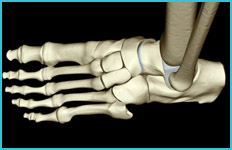
Structurally there are 26 bones with little muscles to move all of them. There are three arches, one on each side that connect to the heel and one across the ball of the foot. They function to absorb and distribute pressure from the weight of the body and to provide a spring for propulsion.
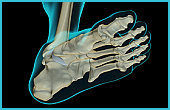
The arches are formed by the configuration of the bone, and by tough connective tissue that works like a bowstring to hold the ends of the bow in a curve (plantar fascia). The middle of the triangle that forms from these three arches is a deep space filled with muscles and tendons that are constantly adjusting in response to changes in body position. The muscles on the sides of the feet work the big and little toes to provide proper tracking of the foot during gait and side-to-side balance. Holding up the arches are other muscles in the lower leg.
Going from superficial to deep, these are the muscle groups in the bottom of the foot and their Trigger Point referral patterns:
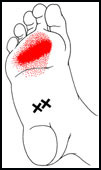 Closest to the skin in the midfoot are the short muscles that crunch your toes (flexor digitorum brevis). On either side of them are the muscles that spread big and little toes away from the midline of the foot (abductor hallucis brevis and abductor digiti minimi). All of these muscles have trigger points into the ball of the foot, the second most common complaint location.
Closest to the skin in the midfoot are the short muscles that crunch your toes (flexor digitorum brevis). On either side of them are the muscles that spread big and little toes away from the midline of the foot (abductor hallucis brevis and abductor digiti minimi). All of these muscles have trigger points into the ball of the foot, the second most common complaint location.
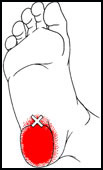 On a deeper level is a four-sided muscle (quadratus plantae) that connects at the back to the heel bone (calcaneus) and at the front in the midfoot to the tendon of the long muscle that crunches the toes (flexor digitorum longus). This muscle is most important in considering the pains of plantar fasciitis because it’s strong referral to the heel mimics the primary pain complaint.
On a deeper level is a four-sided muscle (quadratus plantae) that connects at the back to the heel bone (calcaneus) and at the front in the midfoot to the tendon of the long muscle that crunches the toes (flexor digitorum longus). This muscle is most important in considering the pains of plantar fasciitis because it’s strong referral to the heel mimics the primary pain complaint.
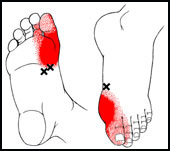 On this same deeper level are also the small muscles that bring the great toe in to grip the floor (flexor hallucis brevis and adductor hallucis). Their Trigger Points refer to the ball of the foot and the big toe.
On this same deeper level are also the small muscles that bring the great toe in to grip the floor (flexor hallucis brevis and adductor hallucis). Their Trigger Points refer to the ball of the foot and the big toe.
 The deepest of the plantar muscles are between the bones of the foot (interossei). They spread and close the toes during walking. The pains of their Trigger Points are very localized in the toes and the base of each toe in the ball of the foot.
The deepest of the plantar muscles are between the bones of the foot (interossei). They spread and close the toes during walking. The pains of their Trigger Points are very localized in the toes and the base of each toe in the ball of the foot.
The next post will give you some basic stretches for these plantar muscles of the foot.